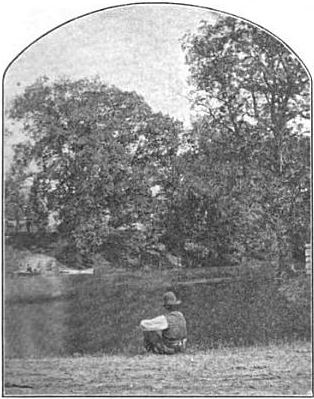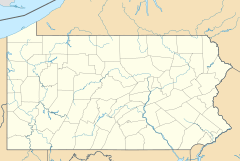Abrahams Creek facts for kids
Quick facts for kids Abrahams Creek |
|
|---|---|

Abrahams Creek in 1878
|
|
| Other name(s) | Abraham Creek, Abraham's Creek, Abram Creek, Abrams Creek |
| Physical characteristics | |
| Main source | Franklin Township, Luzerne County, Pennsylvania between 1,140 and 1,160 feet (350 and 350 m) |
| River mouth | Susquehanna River in Forty Fort, Luzerne County, Pennsylvania 522 ft (159 m) 41°17′07″N 75°52′10″W / 41.28528°N 75.86944°W |
| Length | 10.7 mi (17.2 km) |
| Basin features | |
| Progression | Susquehanna River → Chesapeake Bay |
| Basin size | 17.4 sq mi (45 km2) |
| Tributaries |
|
Abrahams Creek is a stream in Luzerne County, Pennsylvania, in the United States. It flows into the Susquehanna River. The creek is about 10.7 miles (17.2 km) long. It passes through several towns like Franklin Township, Dallas Township, and Forty Fort.
The area of land that drains into Abrahams Creek is called its watershed. This watershed covers about 17.4 square miles (45 km2). It includes parts of nine different towns in Luzerne County. The watershed has two main parts: an upper part that is mostly countryside and a lower part that has many buildings. These two parts are connected by a deep valley called The Hollow.
Abrahams Creek is a stream that flows all year round. Its water quality is not perfect, but it is not considered badly polluted. The creek's name comes from a historic Mohican chief who lived in the area.
Contents
Where Abrahams Creek Flows
Abrahams Creek starts in Franklin Township. It flows generally south, passing through the edges of Dallas and Franklin Townships. Then it enters Kingston Township.
The creek continues south before turning southeast. It then flows into Frances Slocum Lake. After leaving the lake, the creek turns east-northeast and goes through a deep valley. It then flows south-southeast into West Wyoming.
Finally, the creek turns southwest and enters Wyoming. It flows west-southwest, then south, and crosses US Route 11. The creek then flows southwest into Forty Fort. Here, it joins the Susquehanna River.
Smaller Streams Joining Abrahams Creek
Abrahams Creek has six smaller streams that flow into it. None of these smaller streams have official names. Two of them join from the left side, and four join from the right side.
A stream called Hicks Creek used to flow into Abrahams Creek. However, it was moved by mining activities in the 1940s and 1950s. Now, Hicks Creek flows directly into the Susquehanna River.
Water Quality and Flow
Abrahams Creek generally has lower water quality, especially closer to its end. However, the state's environmental department does not consider it to be a polluted stream. It flows continuously throughout the year.
The amount of water flowing in the creek changes. For example, in 1970, the flow was measured at different rates. The creek also carries a lot of sediment (like dirt and small rocks) every day. Much of this sediment comes from farmland and stream banks.
The water in Abrahams Creek has different levels of minerals. It has some magnesium and calcium. The water's pH level is usually close to neutral, meaning it's not too acidic or too basic.
The creek's water temperature can vary a lot, from cool to warm, depending on the time of year.
Land and Rocks Around the Creek
The land around Abrahams Creek changes from high to low. The creek starts at an elevation of about 1,140 to 1,160 feet (350 to 350 m) above sea level. It ends at about 522 feet (159 m) where it meets the Susquehanna River. The highest point in the creek's watershed is Bunker Hill, which is over 1,500 feet (460 m) high.
There are flat areas north of the creek. Also, there are wetlands, which are marshy areas, near the creek. These wetlands are important natural areas. The creek flows through a region known for its ridges and valleys. The Bunker Hill-Mount Lookout Ridge divides the watershed into two parts.
Many parts of Abrahams Creek, especially in its lower sections, have been changed by people. Its channel has been straightened and lined with concrete or rocks to help control floods. This is common in urban areas.
The rocks in the Abrahams Creek watershed are mostly sedimentary rocks. These include types like coal, limestone, sandstone, and shale. Some areas in the watershed have also been affected by strip mining.
The soils in the watershed are mainly different types of clay and silt. These soils affect how water flows into the creek.
The Creek's Watershed
The watershed of Abrahams Creek covers about 17.4 square miles (45 km2). It has about 25 miles (40 km) of open stream channels. This watershed is located in the northeastern part of Luzerne County. It includes parts of nine different towns, such as Exeter, Forty Fort, and Dallas Township.
About 80 percent of the Abrahams Creek watershed is rural, meaning it's countryside. The other 20 percent is urban, with more buildings and development. The lower parts of the watershed are more developed. The upper parts have forests, farms, and some homes.
Forests cover about 51 percent of the watershed. Farmland makes up 26 percent, and developed areas are 18 percent.
Abrahams Creek is a main cause of flooding in towns like West Wyoming and Forty Fort. There are flood protection projects along the creek to help prevent damage. The Slocum Dam, located upstream, also helps reduce flooding. However, smaller, local floods can still happen in the lower parts of the creek.
Abrahams Creek flows through Frances Slocum State Park and goes into Frances Slocum Lake. This lake is a large flood-control lake built in 1965. Most of the water from the upper part of the watershed flows into this lake. There are also other small ponds and dams in the upper parts of the watershed.
The watershed is becoming more developed, but at a slower pace than in the past. The upper areas remain mostly rural, while the lower areas are more urban.
History and Name
Abrahams Creek was officially added to the Geographic Names Information System in 1979. It is also known by other names like Abraham Creek or Abrams Creek. The name "Abraham's Creek" was once its official name.
The creek is named after Abraham, a chief of the Mohican people. His village was historically located along the banks of the creek.
In the past, the land around Abrahams Creek was heavily logged for timber and used for farming.
Many bridges have been built over Abrahams Creek over the years. The oldest one mentioned was built in 1925, carrying State Route 1021. Other bridges were built in the 1930s, 1950s, 1960s, and 1970s. Some of these bridges were considered structurally old in 2007.
The creek and its wetlands have been greatly changed by how people have used the land. Large projects by government groups in the past also changed how water flows in the watershed.
There is a group called the Abrahams Creek Watershed Association. This group works to improve the creek's water quality and protect the area around it. They have received awards for their efforts.
Animals and Plants
Most of the Abrahams Creek watershed has been affected by human activity. However, some of the small streams at the very beginning of the creek are still healthy. The upper part of the watershed is in better condition than the lower part.
The creek's watershed is a good place for coldwater fish and for fish that travel to lay eggs. Wild trout naturally reproduce in a section of one of the creek's smaller streams in West Wyoming.
There are also wetlands along Abrahams Creek, especially upstream of Frances Slocum Lake. These wetlands are home to special plants and birds. For example, a plant called Carex disperma grows there. Birds like the Virginia rail and Sora also live in the area.



